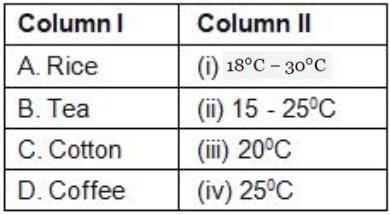Test: Agriculture - 1 - UPSC MCQ
15 Questions MCQ Test - Test: Agriculture - 1
Parts of Himachal Pradesh had evolved a local system of canal irrigation over four hundred years ago. It is called—
The chief characteristics of shifting cultivation are
1. High dependence on manual labour
2. Low level of technology
3. Utilization of poor soils through fallowing
4. Use of chemical fertilizers
Codes:
Double cropping is a common practice in areas having
1. a lot of rainfall.
2. good irrigation facilities.
3. a long growing period.
4. alluvial soils.
Codes:
What are the conditions favourable for tea cultivation?
1. Warm temperature
2. High rainfall
3. High altitude
4. Sloping land
What is the chief cause of low yields of crops in India?
1. Small size of holdings
2. Traditional methods of farming
3. less farmers
4. Low level of farm mechanization
Codes:
Match the Crops with the Soil required by them and accordingly select the correct alternative:

In an area with an annual rainfall of more than 200 cm and sloping hills which crop will be ideal?
Which soil needs little irrigation as it retains soil moisture?
Which of the following crops are grown mostly under subsistence farming?
Match column I with column II and select the correct answer using the code given below the columns:

Which of the following methods is/are suitable for soil conservation in the hilly region?
1. Terracing and contour bunding
2. Shifting cultivation
3. Contour ploughing
Select the correct answer using the codes given below :
Tank irrigation is practised mainly in Peninsular India because
1. undulating relief and hard rocks make it difficult to dig canals and wells
2. rives are rainfed
3. of compact nature of population and agricultural field
Select the correct answer using the codes given below :














